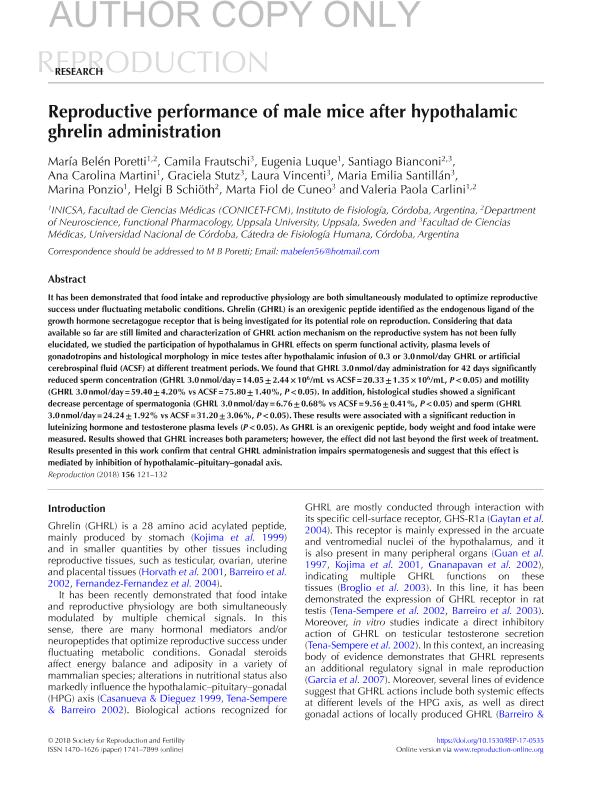Artículo
Reproductive performance of male mice after hypothalamic ghrelin administration
Poretti, María Belén ; Frautschi, Camila Andrea; Luque, Eugenia Mercedes
; Frautschi, Camila Andrea; Luque, Eugenia Mercedes ; Bianconi, Santiago
; Bianconi, Santiago ; Martini, Ana Carolina
; Martini, Ana Carolina ; Stutz, Graciela; Vincenti, Laura María; Santillan, Maria Emilia; Ponzio, Marina Flavia
; Stutz, Graciela; Vincenti, Laura María; Santillan, Maria Emilia; Ponzio, Marina Flavia ; Schiöth, Helgi; Fiol, Marta Haydee
; Schiöth, Helgi; Fiol, Marta Haydee ; Carlini, Valeria Paola
; Carlini, Valeria Paola
 ; Frautschi, Camila Andrea; Luque, Eugenia Mercedes
; Frautschi, Camila Andrea; Luque, Eugenia Mercedes ; Bianconi, Santiago
; Bianconi, Santiago ; Martini, Ana Carolina
; Martini, Ana Carolina ; Stutz, Graciela; Vincenti, Laura María; Santillan, Maria Emilia; Ponzio, Marina Flavia
; Stutz, Graciela; Vincenti, Laura María; Santillan, Maria Emilia; Ponzio, Marina Flavia ; Schiöth, Helgi; Fiol, Marta Haydee
; Schiöth, Helgi; Fiol, Marta Haydee ; Carlini, Valeria Paola
; Carlini, Valeria Paola
Fecha de publicación:
05/2018
Editorial:
BioScientifica
Revista:
Reproduction
ISSN:
1470-1626
Idioma:
Inglés
Tipo de recurso:
Artículo publicado
Clasificación temática:
Resumen
It has been demonstrated that food intake and reproductive physiology are both simultaneously modulated to optimize reproductive success under fluctuating metabolic conditions. Ghrelin (GHRL) is an orexigenic peptide identified as the endogenous ligand of the growth hormone secretagogue receptor that is being investigated for its potential role on reproduction. Considering that data available so far are still limited and characterization of GHRL action mechanism on the reproductive system has not been fully elucidated, we studied the participation of hypothalamus in GHRL effects on sperm functional activity, plasma levels of gonadotropins and histological morphology in mice testes after hypothalamic infusion of 0.3 or 3.0 nmol/day GHRL or artificial cerebrospinal fluid (ACSF) at different treatment periods. We found that GHRL 3.0 nmol/day administration for 42 days significantly reduced sperm concentration (GHRL 3.0 nmol/day = 14.05 ± 2.44 × 106/mL vs ACSF = 20.33 ± 1.35 × 106/mL, P< 0.05) and motility (GHRL 3.0 nmol/day = 59.40 ± 4.20% vs ACSF = 75.80 ± 1.40%, P< 0.05). In addition, histological studies showed a significant decrease percentage of spermatogonia (GHRL 3.0 nmol/day = 6.76 ± 0.68% vs ACSF = 9.56 ± 0.41%, P< 0.05) and sperm (GHRL 3.0 nmol/day = 24.24 ± 1.92% vs ACSF = 31.20 ± 3.06%, P< 0.05). These results were associated with a significant reduction in luteinizing hormone and testosterone plasma levels (P< 0.05). As GHRL is an orexigenic peptide, body weight and food intake were measured. Results showed that GHRL increases both parameters; however, the effect did not last beyond the first week of treatment. Results presented in this work confirm that central GHRL administration impairs spermatogenesis and suggest that this effect is mediated by inhibition of hypothalamic–pituitary–gonadal axis.
Palabras clave:
ghrelin
,
reproduction
,
testosterone
,
LH, FSH
Archivos asociados
Licencia
Identificadores
Colecciones
Articulos(INICSA)
Articulos de INSTITUTO DE INVESTIGACIONES EN CIENCIAS DE LA SALUD
Articulos de INSTITUTO DE INVESTIGACIONES EN CIENCIAS DE LA SALUD
Citación
Poretti, María Belén; Frautschi, Camila Andrea; Luque, Eugenia Mercedes; Bianconi, Santiago; Martini, Ana Carolina; et al.; Reproductive performance of male mice after hypothalamic ghrelin administration; BioScientifica; Reproduction; 156; 2; 5-2018; 121-132
Compartir
Altmétricas



